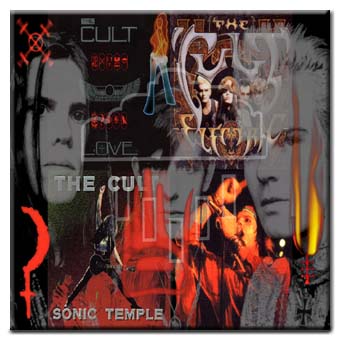The Cult
FEATURED: Saturday, March 3rd, 2001
FORMED: 1982, Bradford, W. Yorks, England
DISBANDED: 1995
REUNITED: 1999
Following a succession of name and stylistic changes, the Cult emerged in 1984 as one of England's leading heavy metal revivalists. Picking up the pseudo-mysticism and native American obsessions of the Doors, the guitar-orchestrations of Led Zeppelin and the three-chord crunch of AC/DC, while adding touches of post-punk goth-rock, the Cult gained a dedicated following in their native Britain with mid-'80s singles like "She Sells Sanctuary" before breaking into the American metal market in the late '80s with "Love Removal Machine." Though the group managed one Top Ten American with 1989's Sonic Temple, the band was plagued with offstage tensions and problems which prevented them from retaining their popularity. Following a pair of unsuccessful records, the Cult split in 1995, but then reunited for a successful tour in 1999.
The origins of the Cult lie in the Southern Death Cult, a goth-rock outfit formed by vocalist Ian Astbury (b. May 14, 1962) in 1981. Astbury was the son of a merchant navy man, which meant he moved frequently during his youth; at one point in his childhood, his family lived in Canada, where the young Ian became fascinated with native Americans, which would become a recurring theme in his songwriting. Astbury eventually settled in Bradford, Yorkshire, where he met a group comprised of David Burrows (guitar), Barry Jepson (bass) and Haq Quereshi (drums). Ian joined the group as their lead vocalist (performing with the last name of "Lindsay," which was his mother's maiden name) and had the group renamed the Southern Death Cult. At only their fifth concert, the band was attracting audiences of 2, 000. In December of 1982, the Southern Death Cult released their first single -- the double A-side "Moya" / "Fatman" -- and the following month, they supported Bauhaus on tour. Though the group's future was looking bright, Astbury pulled the plug on the band because he was frustrated with the positive articles he was receiving in the press. The remaining three members joined Getting the Fear, which eventually became Into a Circle; in the late '80s, Quereshi became a member of Fun-Da-Mental. All of the Southern Death Cult recordings were eventually released in 1986.
Following the disbandment of the Southern Death Cult, Astbury shortened the name of the group to Death Cult and recruited guitarist Billy Duffy -- who had previously played with Morrissey in the pre-Smiths band, the Nosebleeds, as well as Theatre of Hate -- and drummer Ray Mondo and bassist Jamie Stewart, who had previously played with Ritual. Death Cult released an eponymous EP in the summer of 1983; on the EP, Astbury reverted back to his given name. Later in the year, Mondo was replaced by Nigel Preston, who had previously played with Duffy in Theatre of Hate; coincidentally, Mondo became the drummer for Preston's previous band, Sex Gang Children.
In early 1984, the band shed "Death" from the title, fearing that the word gave them the mis-leading appearance of being a goth band. Where both Southern Death Cult and Death Cult had been overtly influenced by post-punk, the Cult was a heavy hard-rock band, with slight psychedelic flourishes. Dreamtime, the group's first album, was released in the fall of 1984, accompanied by a single "Spiritwalker," which reached number one on the UK in the spring. Dreamtime reached number 21 on the UK charts. In the spring of 1985, Preston left the group. For the group's summer single, "She Sells Sanctuary," the band was joined by Big Country's drummer, Mark Brzezicki. "She Sells Sanctuary" became a major UK hit, peaking at number 15. During the recording of the group's second album, drummer Les Warner joined the group. Love, released in the fall of 1985, continued the hard-rock direction of its teaser single and became a number four hit in Britain.
For their third album, the Cult shuffled its lineup -- Stewart moved to rhythm guitar, while former Zodiac Mindwarp bassist Kid Chaos joined the lineup -- and hired Rick Rubin as producer and the result, Electric, was their hardest, heaviest record to date. The first single from the album, "Love Removal Machine," became a number 18 hit in the spring of 1987, which the album itself reached number four in the UK upon its April release. Later that year, Electric gained the Cult a fanbase within America, and the album cracked the US Top 40.
In 1988, the group fired Chaos and Warner, replacing the latter with Matt Sorum; the band failed to hire another bassist. The new lineup released Sonic Temple, which would prove to be its most successful album. The hit single "Fire Woman" helped propel the album into the American Top 10 and within no time, the Cult were seen hanging out with the likes of Motley Crue and Aerosmith, as well as supporting Metallica on the Damaged Justice tour. Though the group was experiencing its best sales, it was fraying behind the scenes, due to in-fighting and substance abuse. By the time they recorded their follow-up to Sonic Temple, Sorum had left to join Guns N Roses and Stewart had quit; they were replaced by drummer Mickey Curry and bassist Charlie Drayton. The resulting album, Ceremony, was released in the fall of 1991 to weak reviews and disappointing sales.
Following the release of Ceremony, the group took a break for the next three years. In 1993, the band released the UK-only hits compilation, Pure Cult, which debuted at number one. By the summer of 1993, the Cult had a new rhythm section, featuring former Mission bassist Craig Adams and drummer Scott Garrett. This lineup recorded The Cult, which was released in late 1994 to poor reviews and sales. In the spring of 1995, the Cult disbanded, with Ian Astbury forming the Holy Barbarians later in the year. Billy Duffy briefly played with Miles Hunt's Vent 414 before leaving to pursue a solo project.
Stephen Thomas Erlewine, All-Music Guide





